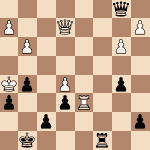Key Points
- Don’t Trust Your Opponent’s Analysis
- The Tree of Analysis: First Breadth, then Depth
1.e4 c5 2.Nf3 e6 3.d4 cxd4 4.Nxd4 Nf6 5.Nc3 Nc6 6.Nxc6 bxc6 7.e5 Nd5 8.Ne4 Qa5+ 9.Bd2 Qc7 10.f4 Qb6 11.Qc1
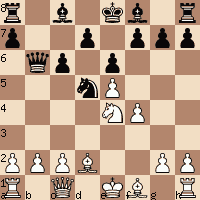
11.Qc1 was too passive. I had to be willing to sacrifice the knight pawn, and it’s even best for Black not to capture. I didn’t realize this at the time, and Black gets a temporary advantage after this inferior queen move.
11...Rb8 12.c4 Qd4 13.Ng5 Nb4 14.Bc3
Let’s look at Black’s best move before continuing with the game.
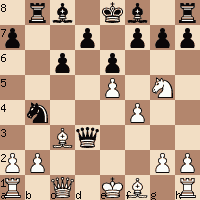
That was well worth checking out! So now let’s return to the game.
14...Nd3+ 15.Kd2 Bb415...Nxc1+ 16.Bxd4 and the knight is trapped.
We’ve reached critical mass. The position is chaotic, and needs a diagram.
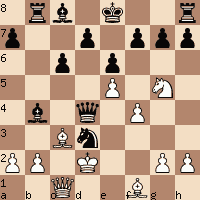
At first glance it looks like White’s in trouble, but Black is losing his knight, and despite all the confusion, that’s the most important thing happening on the board. Now there’s a long tactical sequence, and we begin a new phase.
16.Bxd3 Bxc3+ 17.bxc3 Qxf4+ 18.Kd1 Qg4+ 19.Be2 Qxg2 20.Bf3 Qf2 21.Qd2 Qc5 22.Qf4 Qf2
Don’t Trust Your Opponent’s Analysis
I didn’t think my opponent could allow 23.Qxf7 with check. However, he played 22...Qf2 with an air of confidence. I looked at the position for a few minutes, and decided it was too dangerous to make the capture
However, there were two good variations. They both start out with 23.Qxf7+ Kd8. After that there were two good continuations:
First let’s look at the tactical line:
23.Qxf7+ Kd8 24.Qxg7 Rb2 25.Nxe6+ (a key tactic that allows the queen to capture on h7 with check, and then return to defend against mate and protect the bishop on f3) dxe6 26.Qxh8+ Kc7 27.Qxh7+ Kb8 28.Qd3
Now let’s look at simple consolidation:
23.Qxf7+ Kd8 24.Qf4 Rb2 25.Ne4 Qc2+ 26.Ke1 and White consolidates easily.
So do I feel bad that I didn’t see 25.Nxe6?
Absolutely not. Very few players under 2400 would have seen that variation.
How about the retreat to f4?
For some reason, capturing on f7, then retreating to f4 did not occur to me during the game. That’s because I completely focused on capturing the pawn on g7, and then looking to find a way to protect both my Bishop on f3, and mate on d2.
Tree of Analysis: First Breadth, then Depth
My tunnel vision in this game provides the opportunity to make a key point.
Do a general survey of the key ideas before you start analyzing a specific variation in great depth. On many occasions, I have spent a great deal of time and energy, looking six or seven moves deep in a certain variation, only to find I missed something simple and better way back at the beginning.
23.Qd2 Qc5 24.Qd4
Since I rejected the Qxf7 line I decided it was better to be centralized.
24...Qa3 25.Kd2 Rb2+ 26.Kd3 Ba6 27.Rhb1
This is designed against the threat of Rb4, and I decided it was worth a pawn to simplify the position.
27...0–0 28.Rxb2 Qxb2 29.Rf1 Qxh2 30.Rh1 Qg3 31.Rg1 Qh2 32.Rh1Qg3
Sometimes it’s good to repeat moves to save time on the clock.
Qe4 f5 34.exf6 Qxg5
We both missed this amazing move:
34...Bxc4+
Now there are three options:
35.Kxc4 and d5 wins the queen
35.Qxc4 and Black can capture the knight
35.Kc2 and Black is actually better (he just won a pawn, and his bishop is now in the game.
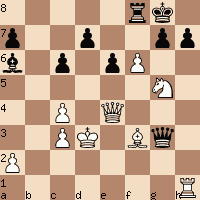
It doesn’t surprise me too much that something like this popped up. You’ll find that all kinds of amazing tactical opportunities present themselves in chaotic positions. If you’re in time trouble, then you should use every moment to analyze concrete variations, even when it’s your opponent’s move.
After Black misses this opportunity, it’s finally time to finish the contest.
35.Qxh7+ Kf7 36.fxg7 Rg8 37.Bh5+ Kf6 38.Rf1+ Ke5 39.Qxg8 Qh440.Qb8+ d6 41.Bg4
This was a creative way of defending c4.
If Black captures the bishop, his queen will no longer hold e1 … so White will check with his rook on that square … the King goes to the f file … White plays Qf8 check Black’s king goes to the g file … and then White queens his pawn under ideal circumstances.
Picture here: Bg4 (Creative way to defend c4)
41…Qh7+ 42.Rf5+ exf5 43. g8 (queen) resigns.
